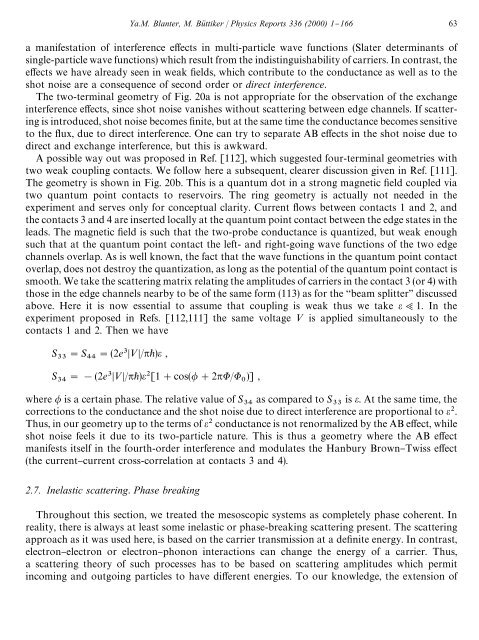shot noise in mesoscopic conductors - Low Temperature Laboratory
shot noise in mesoscopic conductors - Low Temperature Laboratory
shot noise in mesoscopic conductors - Low Temperature Laboratory
You also want an ePaper? Increase the reach of your titles
YUMPU automatically turns print PDFs into web optimized ePapers that Google loves.
a manifestation of <strong>in</strong>terference e!ects <strong>in</strong> multi-particle wave functions (Slater determ<strong>in</strong>ants of<br />
s<strong>in</strong>gle-particle wave functions) which result from the <strong>in</strong>dist<strong>in</strong>guishability of carriers. In contrast, the<br />
e!ects we have already seen <strong>in</strong> weak "elds, which contribute to the conductance as well as to the<br />
<strong>shot</strong> <strong>noise</strong> are a consequence of second order or direct <strong>in</strong>terference.<br />
The two-term<strong>in</strong>al geometry of Fig. 20a is not appropriate for the observation of the exchange<br />
<strong>in</strong>terference e!ects, s<strong>in</strong>ce <strong>shot</strong> <strong>noise</strong> vanishes without scatter<strong>in</strong>g between edge channels. If scatter<strong>in</strong>g<br />
is <strong>in</strong>troduced, <strong>shot</strong> <strong>noise</strong> becomes "nite, but at the same time the conductance becomes sensitive<br />
to the #ux, due to direct <strong>in</strong>terference. One can try to separate AB e!ects <strong>in</strong> the <strong>shot</strong> <strong>noise</strong> due to<br />
direct and exchange <strong>in</strong>terference, but this is awkward.<br />
A possible way out was proposed <strong>in</strong> Ref. [112], which suggested four-term<strong>in</strong>al geometries with<br />
two weak coupl<strong>in</strong>g contacts. We follow here a subsequent, clearer discussion given <strong>in</strong> Ref. [111].<br />
The geometry is shown <strong>in</strong> Fig. 20b. This is a quantum dot <strong>in</strong> a strong magnetic "eld coupled via<br />
two quantum po<strong>in</strong>t contacts to reservoirs. The r<strong>in</strong>g geometry is actually not needed <strong>in</strong> the<br />
experiment and serves only for conceptual clarity. Current #ows between contacts 1 and 2, and<br />
the contacts 3 and 4 are <strong>in</strong>serted locally at the quantum po<strong>in</strong>t contact between the edge states <strong>in</strong> the<br />
leads. The magnetic "eld is such that the two-probe conductance is quantized, but weak enough<br />
such that at the quantum po<strong>in</strong>t contact the left- and right-go<strong>in</strong>g wave functions of the two edge<br />
channels overlap. As is well known, the fact that the wave functions <strong>in</strong> the quantum po<strong>in</strong>t contact<br />
overlap, does not destroy the quantization, as long as the potential of the quantum po<strong>in</strong>t contact is<br />
smooth. We take the scatter<strong>in</strong>g matrix relat<strong>in</strong>g the amplitudes of carriers <strong>in</strong> the contact 3 (or 4) with<br />
those <strong>in</strong> the edge channels nearby to be of the same form (113) as for the `beam splittera discussed<br />
above. Here it is now essential to assume that coupl<strong>in</strong>g is weak thus we take ;1. In the<br />
experiment proposed <strong>in</strong> Refs. [112,111] the same voltage < is applied simultaneously to the<br />
contacts 1 and 2. Then we have<br />
S "S "(2e
















